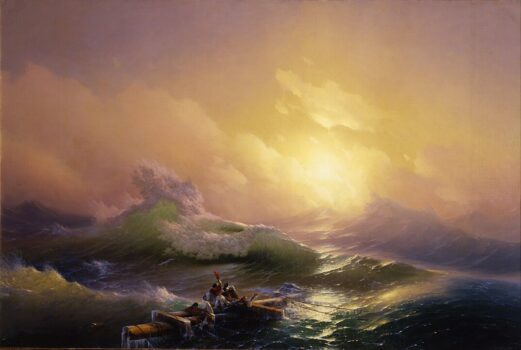The Ninth Wave by Ivan Aivazovsky
On a storm-lashed night in 1850, the Russian painter Ivan Aivazovsky set brush to canvas, conjuring a vision so powerful, so emotionally charged, that it would come to define not only his career but also the very soul of marine painting. This masterpiece, known to the world as “The Ninth Wave,” is more than a depiction of nature’s fury , it is a meditation on human resilience, divine grace, and the beauty that glimmers even in the face of devastation.
Today, “The Ninth Wave” is considered Aivazovsky’s magnum opus , a seascape that captures the imagination and spirit of Romanticism, nestled within the grand halls of Russia’s most prestigious museum. But to understand why this painting continues to move hearts nearly two centuries after its creation, one must first dive into the life of the man behind the brush, the circumstances that birthed the painting, and the haunting mystery of the ninth wave itself.
Who Painted “The Ninth Wave”?
Ivan Konstantinovich Aivazovsky, born in 1817 in the port city of Feodosia (in Crimea, then part of the Russian Empire), was a painter whose soul was inextricably tied to the sea. Of Armenian descent, Aivazovsky was raised in an environment of modest means, but he showed prodigious artistic talent from an early age. He studied at the Imperial Academy of Arts in Saint Petersburg and, upon graduating, quickly rose to prominence due to his extraordinary ability to depict water , not as a static background, but as a living, breathing entity.
Unlike many of his contemporaries, Aivazovsky did not paint from direct observation en plein air. Instead, he painted from memory, imagination, and emotional response. This allowed him to infuse his seascapes with a romantic intensity that transcended literal representation.
When Was “The Ninth Wave” Painted?
“The Ninth Wave” was painted in 1850, during what could be considered the peak of Aivazovsky’s creative powers. At 33 years old, he had traveled widely throughout Europe and had established himself as a master of marine art. It was during his return to Russia, inspired by the natural drama of the Black Sea and perhaps contemplating the deeper currents of life and mortality, that he completed this now-iconic canvas.
What Type of Painting is “The Ninth Wave”?
“The Ninth Wave” is a Romantic marine oil painting, rendered with meticulous technique and emotional grandeur. It falls within the genre of landscape painting, more specifically marine art, which depicts seascapes, ships, and ocean scenes. But beyond its genre classification, “The Ninth Wave” is a profoundly emotional and symbolic work, reflecting the Romantic era’s fascination with the sublime , the beauty and terror of nature’s power.
The canvas measures approximately 221 cm × 332 cm (7.25 ft × 10.9 ft), a monumental size that further amplifies the emotional weight and immersive quality of the work. Oil on canvas was Aivazovsky’s chosen medium, which he used with dazzling skill to evoke the translucent glow of sunlight on water, the tumult of crashing waves, and the delicate figures of survivors clinging to hope.
The Composition and Colors of the Sea
The scene is at once breathtaking and terrifying. A ship has been shattered by a mighty storm, and its survivors cling to the remnants of a mast shaped like a cross , a powerful symbolic element. Around them, the ocean churns in a palette of green, gold, and crimson hues. The sun rises, casting a golden glow across the waves, lending warmth and beauty to what is otherwise a dire situation.
The titular “ninth wave” is a reference to a maritime legend , the belief that waves come in sets, each larger than the last, culminating in a final, most destructive wave , the ninth. In folklore, if you survive this wave, you survive the storm.
Aivazovsky captures the moment just after this colossal ninth wave has passed. The sea is still menacing, but the dawn is breaking. The survivors, adrift on their fragile cross-shaped raft, are not yet safe, but hope has returned to the horizon.
The Ninth Wave Meaning and Theory
1. The Power of Nature and the Sublime
At its surface, the painting is a dramatization of a shipwreck and survival. But on a deeper level, “The Ninth Wave” is an allegory for human struggle in the face of overwhelming natural forces. The sheer size of the ocean, the threat of death, and the storm’s ferocity all speak to the Romantic preoccupation with the sublime , nature’s capacity to inspire both awe and terror.
The survivors’ fate is uncertain, but the warmth of the rising sun suggests salvation. This interplay of light and dark, hope and despair, life and death, is central to the painting’s power.
2. The Symbolism of the Cross
The cross-shaped mast on which the survivors cling is no accident. It is a potent Christian symbol, implying divine protection, sacrifice, and redemption. By using the wreckage of the ship in the form of a cross, Aivazovsky suggests that in moments of extreme trial, faith , or the human spirit , becomes the raft that can carry one through.
3. The Ninth Wave as a Metaphor
The very concept of the ninth wave , a crescendo of hardship , has metaphorical weight. It can be seen as representing the culmination of suffering or life’s most difficult trial. Surviving it becomes a symbol of endurance, resilience, and rebirth. The painting thus becomes a kind of visual parable: you may be battered by storms, but after the darkest wave, dawn comes.
Artistic Techniques and Innovation
Aivazovsky was renowned for his unique handling of light and water. In “The Ninth Wave,” he employs dramatic chiaroscuro, using light not only to define form but to convey spiritual meaning. The transition from the dark, roiling waves to the soft, glowing sky is a masterclass in tonal harmony.
The translucency of the waves, the foamy crests, and the almost cinematic motion of the sea are achieved through thin glazes of oil paint and delicate layering. The golden light that permeates the scene , warm, luminous, and entirely improbable after such a storm , is not realistic but emotive, bending the rules of nature for the sake of narrative.
Despite the technical brilliance, what stands out most is the emotional immediacy. Viewers are not mere spectators; they are pulled into the vortex of the sea, left to wonder what they would do in such circumstances.
Reception and Legacy
From the moment it was unveiled, “The Ninth Wave” was hailed as a masterpiece. Critics marveled at its visual beauty and emotional force. It quickly became one of the most celebrated works of Russian art, and today it is often cited as one of the greatest marine paintings ever created.
Aivazovsky’s contemporaries , both in Russia and abroad , admired the way he captured the sea not just as a setting, but as a character in its own right. The painting became a source of inspiration for poets, composers, and philosophers. Even those unfamiliar with the sea found in it a metaphor for the human experience.
Where is The Ninth Wave Today?
Today, “The Ninth Wave” resides in the State Russian Museum in Saint Petersburg, Russia. It is housed in one of the museum’s grand halls, where its massive scale and glowing palette continue to stun visitors from around the world.
The museum, which holds one of the largest collections of Russian fine art, treats the painting as one of its crown jewels. Art lovers often describe the experience of seeing it in person as overwhelming , not just for its size, but for the emotional gravity it carries.
Why Does “The Ninth Wave” Still Resonate Today?
In an age of climate crises, refugee ships, and existential threats, “The Ninth Wave” feels as timely as ever. It speaks to the eternal human condition , our confrontation with forces larger than ourselves, and the stubborn spark of hope that keeps us afloat.
The survivors in the painting are nameless and faceless, but they could be anyone. They could be us.
And perhaps that is Aivazovsky’s greatest triumph , that through the crashing waves and burning skies of 1850, we still see ourselves reflected. We are reminded that no matter how many waves come, the dawn will rise again.
More Than a Painting
“The Ninth Wave” by Ivan Aivazovsky is more than a seascape , it is a philosophical and emotional exploration of humanity’s place in the world. It embodies the Romantic era’s fascination with the sublime, while also offering a spiritual message of hope and survival. Through his extraordinary use of color, light, and symbolism, Aivazovsky created a painting that transcends time, speaking as urgently to the 21st-century viewer as it did to those who first saw it in the 19th century.
Whether you’re an art historian, a sailor, a spiritual seeker, or simply someone who has faced life’s storms, “The Ninth Wave” offers a mirror , a chance to see that amid chaos and wreckage, beauty and grace still shine.




